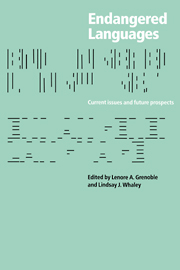Book contents
- Frontmatter
- Contents
- Preface
- List of abbreviations and symbols
- Part I General issues
- Part II Language-community responses
- Part III What is lost: language diversity
- 7 The significance of diversity in language endangerment and preservation
- 8 On endangered languages and the importance of linguistic diversity
- 9 Living words and cartoon translations: Longhouse “texts” and the limitations of English
- 10 Documenting rhetorical, aesthetic, and expressive loss in language shift
- Part IV Mechanisms of language loss
- Appendix
- References
- Index of languages
- Index of names
- General index
7 - The significance of diversity in language endangerment and preservation
Published online by Cambridge University Press: 05 June 2012
- Frontmatter
- Contents
- Preface
- List of abbreviations and symbols
- Part I General issues
- Part II Language-community responses
- Part III What is lost: language diversity
- 7 The significance of diversity in language endangerment and preservation
- 8 On endangered languages and the importance of linguistic diversity
- 9 Living words and cartoon translations: Longhouse “texts” and the limitations of English
- 10 Documenting rhetorical, aesthetic, and expressive loss in language shift
- Part IV Mechanisms of language loss
- Appendix
- References
- Index of languages
- Index of names
- General index
Summary
At long last the tragedy of language loss worldwide has begun to enter the public conscious. In the past, individual communities and linguists have grieved over the disappearance of particular languages, but until recently the general public has been unaware of the accelerating loss of one our most valuable human intellectual resources. As the drama is repeated over and over around the world, it is easy to forget a crucial feature of the phenomenon: the very diversity that makes the loss irreversible. A great variety of languages are being threatened by a multiplicity of factors, in a wide range of community situations. Attitudes toward the impending loss differ both across and within communities. The human and material resources available to those hoping to work toward revitalization and documentation are similarly varied. Because of this diversity, the kinds of goals that are envisioned and feasible differ as well. What these communities do share is the significance of the moment: what they choose to do now, as well as what they fail to do, will have irrevocable consequences for future generations. With business as usual, all will be lost to the descendants of current speakers.
The diversity of languages
Many modern residents of North America are themselves unaware of the phenomenally rich linguistic diversity indigenous to their continent. We will never know exactly how many languages were once spoken in North America, but documentation survives of around 270 distinct, mutually unintelligible languages north of Mexico, and there were once many more.
- Type
- Chapter
- Information
- Endangered LanguagesLanguage Loss and Community Response, pp. 163 - 191Publisher: Cambridge University PressPrint publication year: 1998
- 18
- Cited by



